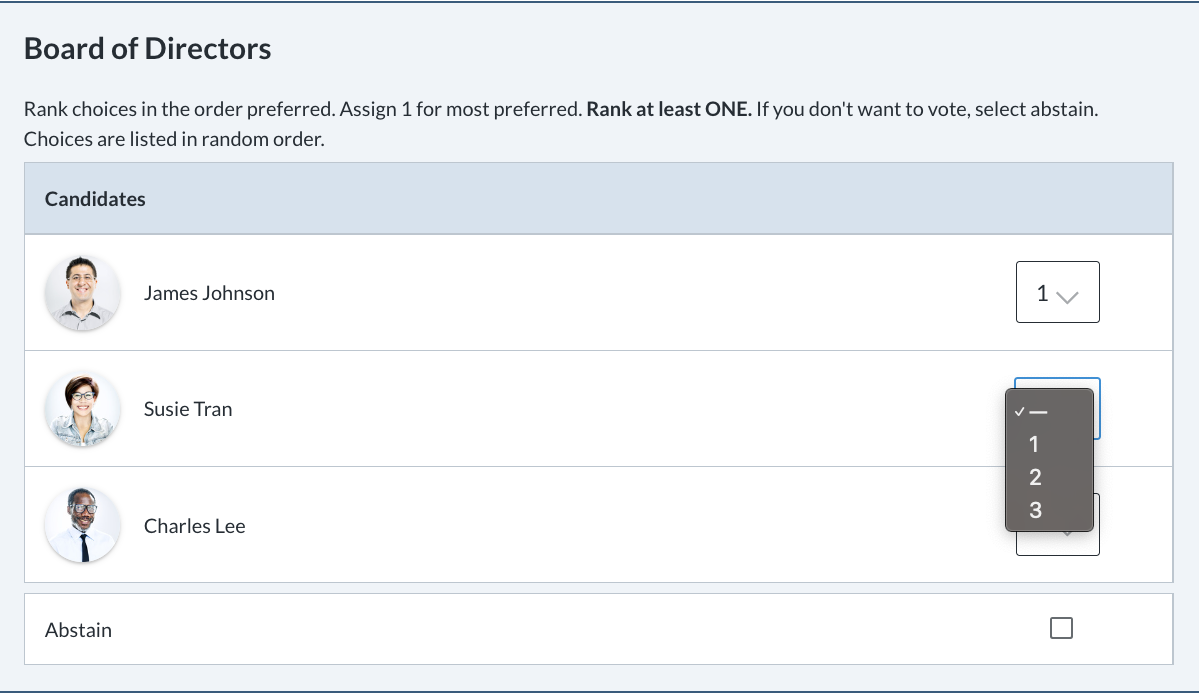Also known as Pairwise Tallying using a Ranked Choice Ballot

In a Condorcet election, candidates are ranked in pairs, and the winner is the candidate who would win against all other candidates in a one-on-one matchup. This means that if there is a candidate who would beat every other candidate in a head-to-head, also known as pairwise, contest, they would be the winner. In other words, it’s like the game rock-paper-scissors with a potentially hundreds or thousands of people playing and potentially more choices than rock, paper or scissors.
Voters rank the candidates in order of preference. If a ranked ballot is used, the voter gives a "1" to their first preference, a "2" to their second preference, ranking all the available choices on the ballot. Overall, a valid ballot for a Condorcet vote should clearly and accurately reflect the voter's preferences, and adhere to any rules or regulations set forth in the instructions. A valid ballot for a Condorcet vote should meet the following considerations:
Once all the valid ballots for the Condorcet vote have been submitted and the voting closes, the votes are then counted pairwise for each pair of candidates. The candidate who receives more votes is declared the winner of that pair. The winner of each pair is then compared to every other candidate, and the candidate who wins the most matchups is declared the overall winner.
Specifically, the winner is determined by comparing entities in pairs to derive a winner. To calculate the pairwise results of a Condorcet election, the following steps can be followed:
| A | B | C | |
| A | |||
| B | |||
| C |
Then, the winner of each box is determined. With a large number of candidates, and or when tallying electronically, sorting and filtering functions can also allow for easy comparisons and calculation of the number of wins by each candidate.
In a Condorcet vote, a candidate wins if they have the most pairwise victories against all other candidates. To illustrate, let's use an example with three candidates: A, B, and C. The pairwise contests between these candidates might look like this:
In this example, A has won two pairwise contests, B has won one, and C has not won any. A would be declared the winner.
As well, in a Condorcet election system, the winning candidate must achieve an absolute majority of the total number of formal votes. This means that the winner of each contest must get more than 50 percent of the total formal votes. The votes are allocated to each candidate based on how the voters have ranked them.
If there is no clear Condorcet winner, additional rounds of voting may be required using other voting methods such as preferential voting to determine the winner.
Here's an example with four candidates: Alice, Bob, Charlie, and Dave. And the comparison occurs as follows:
| Alice | Bob | Charlie | Dave | Total | |
| Alice | Win | Win | Win | 3 Wins | |
| Bob | Loss | Loss | Loss | 0 Wins | |
| Charlie | Loss | Win | Win | 2 Wins | |
| Dave | Loss | Win | Loss | 1 Win |
Based on these results, Alice has 3 wins, Charlie has 2 wins, Dave has 1 win, and Bob has 0 wins. The Condorcet winner is Alice, because she had the most number of wins as compared to Charlie, Dave and Bob.
The goal of the Condorcet system is to ensure that the winner has the broadest possible support among the electorate, through the evaluation of the pairwise comparison and identification of those candidates that are preferred by a majority of voters. This makes the Condorcet system particularly attractive to those who seek to promote a democratic, representative form of voting as compared to some voting methods.
Condorcet voting and Instant Runoff voting both use a ranked ballot, but there are different principles to determine the winner.
In Instant Runoff voting, voters rank the candidates in order of preference. The votes are then counted and the candidate with the most first-choice votes is declared the winner. If no candidate receives a majority of first-choice votes, the candidate with the fewest first-choice votes is eliminated, and the votes for that candidate are redistributed based on the voters' second-choice preferences. This process continues until one candidate has a majority of the votes.
In contrast, with Condorcet voting, the counting process involves comparing each candidate against every other candidate in a head-to-head matchup (pairwise comparison). If there is a candidate who wins against every other candidate in these matchups, they are declared the winner of the election. However, with Condorcet voting, you can have situations where a Condorcet winner doesn't exist, also known as the Condorcet paradox. In this situation, to determine a winner an alternate method such as Instant Run-off or other tie-breaking rules are required. This requires additional time, effort and potentially cost.
Condorcet voting is considered to be a more accurate reflection of the collective preferences of the voters, because it takes into account not only the voters choices, but the comparison of every candidate to every other candidate. However, with manual tallying of paper ballots, Condorcet voting is more complex to implement and count. As well, there is the possibility of a cycle of preferences that doesn't allow for a clear Condorcet winner to emerge. Preferential voting is simpler and more intuitive to understand, and thus tends to be a more commonly used method.